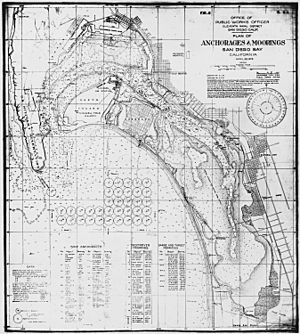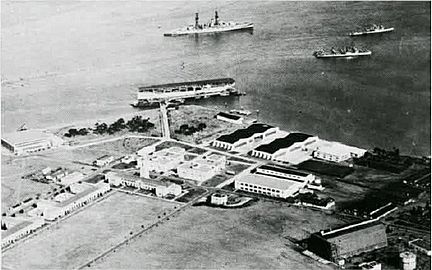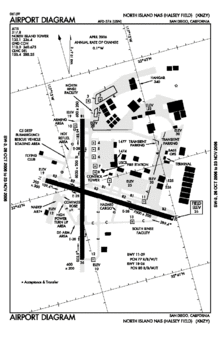Naval Air Station North Island facts for kids
Quick facts for kids Naval Air Station North Island |
|||||||||
|---|---|---|---|---|---|---|---|---|---|
| Halsey Field | |||||||||
| Part of Naval Base Coronado | |||||||||
| San Diego, California in the United States | |||||||||

Three US Navy Nimitz-class aircraft carriers, USS Carl Vinson (CVN-70), USS Ronald Reagan (CVN-76), and USS John C. Stennis (CVN-74) pierside at NAS North Island during June 2015
|
|||||||||
 |
|||||||||
|
Location in the United States
|
|||||||||
| Coordinates | 32°41′57″N 117°12′55″W / 32.69917°N 117.21528°W | ||||||||
| Type | Naval Air Station/Naval Base | ||||||||
| Site information | |||||||||
| Owner | Department of Defense | ||||||||
| Operator | US Navy | ||||||||
| Controlled by | Navy Region Southwest | ||||||||
| Condition | Operational | ||||||||
| Site history | |||||||||
| Built | 1917 (as NAS San Diego) | ||||||||
| In use | 1917 – present | ||||||||
| Garrison information | |||||||||
| Current commander |
Captain John DePree | ||||||||
| Airfield information | |||||||||
| Identifiers | IATA: NZY, ICAO: KNZY, FAA LID: NZY, WMO: 722906 | ||||||||
| Elevation | 7.8 metres (26 ft) AMSL | ||||||||
|
|||||||||
| Other airfield facilities |
13x helipads | ||||||||
Naval Air Station North Island or NAS North Island is a very important place for the United States Navy. It is located at the northern end of the Coronado peninsula in San Diego, California. NAS North Island is part of Naval Base Coronado (NBC). It is also the home base for several large aircraft carriers of the U.S. Navy.
The person in charge of NAS North Island is also the Commanding Officer of Naval Base Coronado. This means they are in charge of NAS North Island and seven other Navy locations nearby. These include Naval Amphibious Base Coronado and Naval Auxiliary Landing Facility San Clemente Island. NAS North Island itself is home to 23 aviation squadrons. It also hosts 80 other groups and activities. One of these, the Fleet Readiness Center Southwest, is San Diego's biggest aerospace employer.
Contents
What is NAS North Island?

NAS North Island is like a small city. It has its own police and fire departments. It also has advanced military security. The base has large factory-like buildings. These are part of the Naval Aviation Depot. About 3,300 civilians work there.
The base also has its own grocery store (commissary) and a Navy Exchange store. There are housing units for military families. For fun, there are clubs, a movie theater, a golf course, tennis courts, and bowling alleys. There are also parks and beaches.
Airfields and Ships at North Island
NAS North Island also manages two other airfields in Southern California. One is Naval Auxiliary Landing Facility San Clemente Island. It is about 70 miles (110 km) northwest of San Diego. The other is Naval Outlying Landing Field Imperial Beach. This airfield is in Imperial Beach, near the U.S.-Mexico border.
The airfield at North Island has over 230 aircraft. Its docks are home to three aircraft carriers: USS Abraham Lincoln, USS Carl Vinson, and USS Theodore Roosevelt. The base was also home to the Navy's special rescue submarines, Mystic (DSRV-1) and Avalon (DSRV-2).
Important Military Groups
North Island is the main office for four major military groups. These include:
- Commander, Naval Air Forces (COMNAVAIRFOR or CNAF). This group is in charge of keeping all Navy aircraft and aircraft carriers ready. They also handle training for them.
- Commander, Naval Air Force, U.S. Pacific Fleet (COMNAVAIRPAC or CNAP). This group does the same for the Pacific Fleet. The same person leads both of these groups.
- Commander, Carrier Strike Group One and Commander, Carrier Strike Group Seven. These groups manage aircraft carrier teams.
With all the ships and people, nearly 35,000 military and civilian staff work at the station. Other companies also fly planes from the air station. They help with training for the Department of Defense (DoD). These planes include C-26 Metroliners and Learjets.
History of North Island

North Island became a Naval Air Station in 1917. It was called Naval Air Station San Diego until 1955. On August 15, 1963, it was officially named the "Birthplace of Naval Aviation." This was because so much early aviation history happened there.
Early Aviation and Important People
The U.S. Navy's first pilot, Lieutenant Theodore G. Ellyson, trained at North Island. This was as early as 1911. This was only eight years after the Orville and Wilbur Wright flew the first airplane. At that time, North Island was just an empty sand flat.
In the late 1800s, it was used for horseback riding and hunting. Guests from the Hotel del Coronado would visit. North Island got its name because it used to be separated from Coronado. A shallow bay called the Spanish Bight was between them. This bay was filled in during World War II in 1945.
Glenn Curtiss opened a flying school on North Island. He let both the U.S. Army and U.S. Navy use the site for training. The Navy opened a station in 1912. The Army also started an aviation school in 1913. In 1917, Congress took over the land. The Navy started with a "Camp Trouble" made of tents. The Navy shared North Island with the Army until 1937. Then, the Army left, and the Navy took over the whole island.
Aviation Milestones
In 1914, aircraft builder Glenn L. Martin flew his plane over the island. During this flight, the first parachute jump in San Diego happened. A woman named Tiny Broadwick made the jump. Other important aviation events happened at North Island. These include the first seaplane flight in 1911. Also, the first mid-air refueling and the first non-stop flight across the country happened here in 1923.
Charles A. Lindbergh started his famous flight from New York to Paris from North Island. He took off from Rockwell Field on North Island on May 10, 1927. The "Blue Angels" of today had early versions called the "Sea Hawks." They performed amazing flight shows as early as 1928. They showed off the skills of Navy fighter and bomber pilots. Sometimes, they even flew with their plane wings tied together!
Many famous American military pilots trained at North Island. But other countries were also interested in aviation. Six years before the Naval Air Station opened, Glenn Curtiss trained the first Japanese pilots there. Among them were Lieutenant Sadayoshi Yamada, who later led the Imperial Japanese Navy Air Service in World War II. Also, Chikuhei Nakajima, who started the Nakajima Aircraft Company, trained there.
Even the base's first leader, Lieutenant Commander Earl Winfield Spencer Jr., was famous. His wife was Wallis Warfield. She later became the Duchess of Windsor. King Edward VIII gave up his throne for her in 1936.
North Island During World War II
During World War II, North Island was a major base in the U.S. It supported forces in the Pacific Ocean. These forces included many aircraft carriers, the Coast Guard, Army, Marines, and Seabees. The city of Coronado became home to many factory workers and families. The base worked all day and night.
Big USO entertainment shows were held weekly. Famous people like Douglas Fairbanks Jr. and Guy Madison were stationed there. Stars like the Marx Brothers and Bob Hope often performed at USO shows.
-
Four carriers (USS Constellation, USS Carl Vinson, USS Nimitz, USS John C. Stennis) at North Island, 2002
-
Three carriers (U.S.S. Carl Vinson, U.S.S. Nimitz, USS Ronald Reagan) at North Island, 2010
Aircraft Squadrons at North Island
Here are some of the aircraft squadrons based at NAS North Island:
| MH-60S Seahawk | HH-60H Seahawk | MH-60R Seahawk | C-40A Clipper | C-2 Greyhound | CMV-22B (V22) | |
|---|---|---|---|---|---|---|
|
|
|
|
|
|
Ships Based at North Island
These are some of the ships that call NAS North Island their home port:
- USS Carl Vinson (CVN-70)
- USS Theodore Roosevelt (CVN-71)
- USS Abraham Lincoln (CVN-72)
- USS Miguel Keith (ESB-5)
Other Groups at North Island
Many other important Navy groups and commands are located at NAS North Island. They help the base run smoothly and support Navy operations. Some of these include:
- Commander, Naval Air Forces
- Commander, Naval Air Forces, Pacific Fleet (COMNAVAIRPAC)
- Commander, Helicopter Maritime Strike WING Pacific
- Commander, Carrier Strike Group One (CCSG-1)
- Commander, Carrier Strike Group Three (CCSG-3)
- Commander, Carrier Strike Group Seven (CCSG-7)
- Commander, Carrier Strike Group Eleven (CCSG-11)
- Deep Submergence Unit (DSU)
- Fleet Readiness Center Southwest
- Naval Air Technical Data and Engineering Service Center (NATEC)
- Naval Computer and Telecommunications Station
- Center for Naval Aviation Technical Training Unit (CNATTU)
- Navy Reserve Center North Island
Weather at North Island
NAS North Island has very warm winters. It is one of the warmest places on the west coast of the U.S. The climate is called a semi-arid climate. This means it is warm and dry, like a warm steppe.
| Climate data for North Island NAS (32.7°N, 117.2°W Altitude: 7.9 m asl) | |||||||||||||
|---|---|---|---|---|---|---|---|---|---|---|---|---|---|
| Month | Jan | Feb | Mar | Apr | May | Jun | Jul | Aug | Sep | Oct | Nov | Dec | Year |
| Mean daily maximum °C (°F) | 20.4 (68.8) |
20.2 (68.3) |
20.5 (68.9) |
21.4 (70.5) |
22.1 (71.7) |
23.1 (73.6) |
25.3 (77.5) |
26.1 (78.9) |
25.8 (78.5) |
24.4 (75.9) |
22.4 (72.3) |
20.2 (68.3) |
22.7 (72.8) |
| Daily mean °C (°F) | 15.4 (59.8) |
15.7 (60.3) |
16.6 (61.9) |
17.8 (64.1) |
19.1 (66.3) |
20.3 (68.6) |
22.3 (72.1) |
23.1 (73.6) |
22.5 (72.5) |
20.6 (69.0) |
17.7 (63.8) |
15.2 (59.3) |
18.9 (65.9) |
| Mean daily minimum °C (°F) | 10.4 (50.8) |
11.3 (52.4) |
12.7 (54.9) |
14.2 (57.6) |
16.1 (60.9) |
17.6 (63.7) |
19.3 (66.8) |
20.1 (68.2) |
19.2 (66.6) |
16.7 (62.1) |
13.0 (55.4) |
10.2 (50.3) |
15.1 (59.1) |
| Average precipitation mm (inches) | 43 (1.69) |
52 (2.04) |
42 (1.66) |
18 (0.72) |
2.0 (0.08) |
1.5 (0.06) |
0.51 (0.02) |
0.51 (0.02) |
3.8 (0.15) |
17 (0.65) |
24 (0.93) |
35 (1.39) |
239.32 (9.41) |
| Source 1: http://www.ncdc.noaa.gov/cdo-web/datatools/normals | |||||||||||||
| Source 2: http://www.ncdc.noaa.gov/cdo-web/datasets/normal_mly/stations/GHCND:USW00093112/detail | |||||||||||||
Schools for Families at North Island
Families living on the base attend schools in the Coronado Unified School District. This includes Village Elementary School, Coronado Middle School, and Coronado High School.
See also
 In Spanish: Base Aeronaval de North Island para niños
In Spanish: Base Aeronaval de North Island para niños









